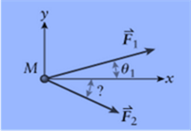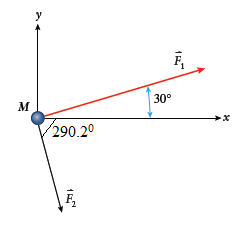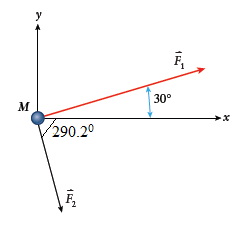
Concept explainers
(a)
The magnitude of
Answer to Problem 62QAP
The magnitude of
Explanation of Solution
Given info:

Mass,
Acceleration,
And
Formula Used:
Calculation:
Consider as two forces are attached to an object of mass M.
Let rope
We need to determine the magnitude and direction of rope
We are told that the box accelerates only in the x-direction at a rate of
We can use Newton's second law in component form in order to calculate the components and, therefore, the magnitude and direction of force
Conclusion:
The magnitude of
(b)
A careful drawing to show direction of
Answer to Problem 62QAP
The below diagram shows the direction of

Explanation of Solution
Given info:

Mass,
Acceleration,
And
Formula Used:
Calculation:
Consider as two forces are attached to an object of mass M.
Let rope
We need to determine the magnitude and direction of rope
We are told that the box accelerates only in the x-direction at a rate of
We can use Newton's second law in component form in order to calculate the components and, therefore, the magnitude and direction of force
On substituting given values we have: -
290.20
Conclusion:
Thus, we obtained the direction of

Want to see more full solutions like this?
Chapter 4 Solutions
COLLEGE PHYSICS
- 2 - When the force F is applied to the mass m1 in the frictionless plane, the object gains an acceleration of 4 m / s2. When the same force F is applied to a mass of m2, what is the ratio m1 / m2 as the object gains an acceleration of 12 m / s2?A) 2B) 3C) 5D) 4E) 1arrow_forwardA chain of three monkeys is hanging vertically from a tree branch. Each monkey has a mass of 12 kg. What is the magnitude of the force that monkey #2 exerts on monkey #1? Now monkey #1 pulls the other two upwards with a constant acceleration of 2.50 m/s2. As before, the mass of each monkey is 12 kg. What is the magnitude of the force monkey #3 exerts on monkey #2?1arrow_forwardAn object of mass m = 1.0 kg is observed to have an acceleration a with a magnitude of 10.0 m/s2 in the direction 60.0O east of north. The force F2 acting on the object has a magnitude of 5.0 N and is directed north. Determine the magnitude and direction of the one other horizontal force F1 acting on the object.arrow_forward
- A 1.00 kg object is observed to have an acceleration of 10.0 m/s in a direction 60.0 east of north the force F2 exerted on the object has a magnitude of 5.00 N and is directed north determine the magnitude and direction of the force F1 acting on the object.arrow_forwardTwo crates, A and B, sit side by side on a frictionless horizontal surface. The crates havemasses Ma and Mb. A horizontal force F is applied to crate A and the two crates move offto the right. (a) Draw clearly labelled FBD for Crate A and Crate B. (b) If the magnitudeof force F is less than the total weight of the two crates, will it cause the crates to move?Why or why not?arrow_forward1. A crate is lying on a plane inclined at an angle ɵ. What is the angle between the weight of the crate and the force exerted by the plane on the crate? a) θ - 180° b) θ c) 180° - θ d) 180° 2. An object is being acted upon by an unbalanced force if a) it is speeding up b) it is slowing down c) it changes its direction d) all of the abovearrow_forward
- P4-6 A ball of mass m=0.49 kg hangs on a light rope from the ceiling of a train. The train accelerates forward, on horizontal tracks, in the positive x direction. The string makes an angle of ϕ=31∘ with vertical. A coordinate system is provided. Part (b) Write an expression for the vertical component of the net force. Part (c) What is the numeric value, in newtons, of the tension in the rope? Part (d) What is the magnitude, in meters per squared second, of the acceleration of the train?arrow_forwardAs a fish jumps vertically out of the water, assume that only two significant forces act on it: an upward force F exerted by a tail fin and the downward force due to gravity. A record Chinook salmon has a length of 1.50 m and a mass of 48.5 kg. if this fish is moving upward at 3.00 m/s as its head first breaks the surface and has an upward speed of 5.80 m/s after two-thirds of its length has left the surface. what is the magnitude of the force F during the intervalarrow_forwardOnly one force acts on an object. Can the object have zero acceleration? Can it have zero velocity? Explain you answer in words.arrow_forward
- 4- In the situation below, there is friction between the block of mass m1 and the surface so that μe=0.4μe=0.4 and μc=0.25μc=0.25. The slope of the plane is such that θ=40º c) Assuming that the mass of block 2 is 40 kg and that the mass of block 1 is 10 kg. Under this situation, block 2 descends accelerated and block 1 ascends the accelerated inclined plane, but still under friction, but this time of kinetic nature. Knowing that, according to the above scheme, the acceleration of block 1 has a magnitude 4 times greater than the magnitude of the acceleration of block 2, determine what is the magnitude of the acceleration of each block. Present your calculations d) If the height marked in the figure is 20 m and block 2 starts its movement at rest, determine how long it will take to touch the ground. Present your calculationsarrow_forwardA 4.0-kg square block is on an incline plane of 30 degrees angle with respect to the ground. 1)What is the minimum coefficient of static friction (μs)min is need to prevent it from sliding down the incline? 2) When the surface μs is 0.30 to prevent the block sliding, a horizontal force F, parallel to the ground, is applied to the block. find the minimum magnitude of F required to keep the block from moving. 3) When a 20 N uphill force is applied to the block, the block starts to move up along the incline. Find the acceleration of the blockarrow_forwardTwo forces are acting on a 0.150 kg hockey puck as it slides along the ice. The first force has a magnitude of 0.320 N and points 35.0° north of east. The second force has a magnitude of 0.520 N and points 65.0° north of east. If these are the only two forces acting on the puck, what will be the magnitude and direction of the puck's acceleration? Enter the direction as an angle measured in degrees counterclockwise from due east. magnitude of acceleration: m/s2 direction of acceleration: °arrow_forward
 Physics for Scientists and Engineers: Foundations...PhysicsISBN:9781133939146Author:Katz, Debora M.Publisher:Cengage Learning
Physics for Scientists and Engineers: Foundations...PhysicsISBN:9781133939146Author:Katz, Debora M.Publisher:Cengage Learning College PhysicsPhysicsISBN:9781305952300Author:Raymond A. Serway, Chris VuillePublisher:Cengage Learning
College PhysicsPhysicsISBN:9781305952300Author:Raymond A. Serway, Chris VuillePublisher:Cengage Learning College PhysicsPhysicsISBN:9781938168000Author:Paul Peter Urone, Roger HinrichsPublisher:OpenStax College
College PhysicsPhysicsISBN:9781938168000Author:Paul Peter Urone, Roger HinrichsPublisher:OpenStax College Physics for Scientists and Engineers, Technology ...PhysicsISBN:9781305116399Author:Raymond A. Serway, John W. JewettPublisher:Cengage Learning
Physics for Scientists and Engineers, Technology ...PhysicsISBN:9781305116399Author:Raymond A. Serway, John W. JewettPublisher:Cengage Learning College PhysicsPhysicsISBN:9781285737027Author:Raymond A. Serway, Chris VuillePublisher:Cengage Learning
College PhysicsPhysicsISBN:9781285737027Author:Raymond A. Serway, Chris VuillePublisher:Cengage Learning Principles of Physics: A Calculus-Based TextPhysicsISBN:9781133104261Author:Raymond A. Serway, John W. JewettPublisher:Cengage Learning
Principles of Physics: A Calculus-Based TextPhysicsISBN:9781133104261Author:Raymond A. Serway, John W. JewettPublisher:Cengage Learning





